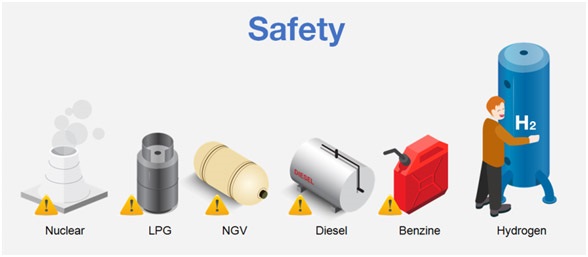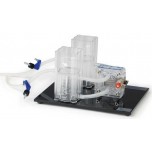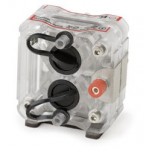 Hydrogen has many unusual characteristics compared with other elements. Some of these interesting and unusual characteristics include:
Hydrogen has many unusual characteristics compared with other elements. Some of these interesting and unusual characteristics include:
• Hydrogen does not exist in its natural form on earth; therefore, it must be manufactured through steam reforming of natural gas, the gasification of coal, electrolysis, or the reforming/oxidation of other hydrocarbons or biomass.
• It is the lightest and most abundant element.
• It can burn with oxygen to release large amounts of energy.
• Hydrogen has a high energy content by weight.
• It has a low energy density by volume at standard temperature and atmospheric pressure.
• Like any other gas, the volumetric density can be drastically lowered by storing compressed hydrogen under pressure, or converting it to liquid hydrogen.
• Hydrogen burns when it makes up 4 to 75% of air by volume.
• Many pollutants are formed when hydrogen is burned in air because of the high nitrogen content of the air.
Table 1 compares relevant properties of hydrogen, methane, methanol, ethanol, propane, and gasoline—all of which can be used as fuel for fuel cells.
| Property | Hydrogen | Methane | Methanol | Ethanol | Propane | Gasoline |
| Molecular Weight (g/mol) | 2.016 | 16.043 | 32.040 | 46.063 | 44.100 | ~107.000 |
| Density (kg/m3 at 20°C and 1 atm) | 0.08375 | 0.6682 | 791 | 789 | 1.865 | 751 |
| Normal Boiling point (°C) | -252.8 | -161.5 | 64.5 | 78.5 | -42.1 | 27 - 225 |
| Flash Point (°C) | < -253 | -188 | 11 | 13 | -104 | -43 |
| Flammability Limits in Air (Volume %) | 4.0 - 75.0 | 5.0 - 15.0 | 6.7 - 36.0 | 3.3 - 19 | 2.1 - 10.1 | 1.0 - 7.6 |
| CO2 Production per Energy Unit | 0 | 1.00 | 1.50 | N/A | N/A | 1.80 |
| Auto-ignition Temperature in Air (°C) | 585 | 540 | 385 | 423 | 490 | 230 - 480 |
| Higher Heating Value (MJ/kg) | 142.0 | 55.5 | 22.9 | 29.8 | 50.2 | 47.3 |
| Lower Heating Value (MJ/kg) | 120.0 | 50.0 | 20.1 | 27.0 | 46.3 | 44.0 |
Hydrogen is a good choice for a future energy source for many reasons. Some of these reasons include:
• Hydrogen has the potential to provide energy to all parts of the economy: industry, residences, transportation, and mobile applications.
• Hydrogen can be made from various sources.
• It is completely renewable.
• The most abundant and cleanest precursor for hydrogen is water.
• Hydrogen can be stored in many forms, from gas to liquid to solid.
• It can be stored in various chemicals and substances such as methanol, ethanol, and metal hydrides.
• It can be produced from, and converted to, electricity with high efficiencies.
• It can be transported and stored as safely as any other fuel.
• It can eventually aid in the release of oil-based fuels used for automobiles.
• It is an attractive solution for remote communities that cannot access electricity through the grid.
One of the fundamental attractions of hydrogen is its environmental advantage over fossil fuels, however, hydrogen is only as clean as the technologies used to produce it. The production of hydrogen can be pollutant-free if it is produced by one of three methods:
• Through electrolysis using electricity derived solely from renewable energy sources or nuclear power.
• Through steam reforming of fossil fuels combined with new carbon capture and storage technologies.
• Through thermochemical or biological techniques based on renewable biomass.
A major disadvantage of processing hydrocarbons is the pollution and carbon dioxide, which eliminates one of the main reasons for using hydrogen in the first place. The best low-pollution alternative for creating hydrogen is a process involving electrolysis of water by electricity. This method creates no carbon dioxide or nitrous or sulfurous oxides.
Hydrogen is currently produced commercially to make other chemicals such as ammonia and urea, for the cracking of petrochemicals, and a feedstock for the food, electronics, and metallurgical processing industries.
Safety Aspects of Hydrogen as a Fuel
The reputation of hydrogen as “unsafe” has been unfairly tainted by the Hindenberg incident and the hydrogen bomb. Although hydrogen has been demonized, investigation into the Hindenberg incident proved that the aluminum power-filled paint varnish that coated the ship started the fire—not the hydrogen. Since hydrogen is a small molecule, it has a tendency to escape through small openings more easily than other fuels. Hydrogen can leak through holes or joints of low pressure fuel lines 1.2 to 2.8 times faster than natural gas. Natural gas has an energy density three times greater than hydrogen, so a natural gas leak results in a greater energy release than a hydrogen leak. Since hydrogen is lighter and more diffusive than gasoline, propane, or natural gas, it disperses much more quickly. If an explosion occurred, hydrogen has the lowest explosive energy per unit of stored fuel.
Liquid hydrogen has a different set of safety issues. If liquid hydrogen spills, it could cause burns. A liquid hydrogen spill is similar to an oil spill, however, it dissipates much more rapidly. Hydrogen systems are designed with the correct controls and valves to release hydrogen safely.
When designing hydrogen systems, manufacturers build the following failure modes into their systems:
• Leak prevention through thorough testing of tanks and equipment.
• Installing more than one valve.
• Designing equipment for shocks, vibrations, and wide temperature ranges.
• Adding hydrogen sensors or leak detectors.
• Ignition prevention by eliminating sources of electrical sparks.
• Designing fuel cell supply lines that are physically separated from other equipment.
In addition to safe system design, international regulations codes and standards need to continue to be developed for construction, maintenance, and operation of hydrogen facilities and equipment in order for hydrogen to become widely accepted. Over time, the uniformity of safety requirements will increase customer confidence in using hydrogen.

 Posted by
Posted by



















Enter the code in the box below: